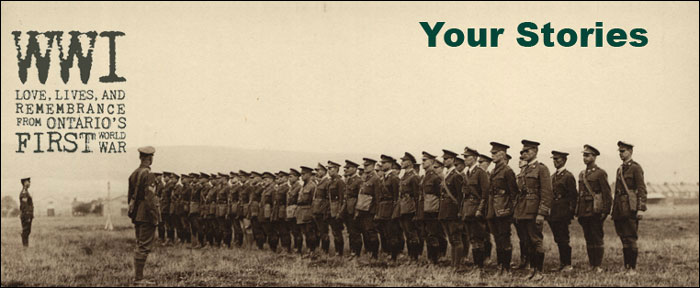
Eaton’s Soldiers Exhibit at Mackenzie House
Thank you for sharing your stories of the soldiers pictured in this online exhibit. These stories formed the basis of an exhibit, Eaton's Goes to War: Memory, Meaning & Family at Mackenzie House, a City of Toronto historic house museum located near the site of the original Toronto Eaton’s store. The exhibit runs from September 21, 2017 to January 31, 2018.
Stories -
Listed by Soldiers Last Name
James Barr
My father, Private James Barr, was an Eaton’s employee prior to the First World War. He enlisted at age 18 on November 18, 1916 shortly after his older brother, Pte. Peter Barr, was killed in France.
He was originally assigned to the 208th Overseas Battalion which embarked from Halifax on the H.M.S. Justica, arriving in Liverpool on May 14, 1917.
He remained in England for almost a year and on March 29, 1918 he arrived in France assigned to the 116th Overseas Battalion. In May 1918, he was with the Canadian Field Artillery and later that same month he was transferred to 3rd Battalion Machine Gun Corp.
His medical records indicate he was in and out of the hospital on several occasions over the next year and was struck off strength on March 15, 1919.
He sailed from Southampton to Canada on the R.M.S. Olympic on March 19, 1919 and was officially discharged from the 3rd Battalion C.M.C. at 2 District Depot, Toronto, although my Dad never spoke of the war, I was led to believe he had been wounded. He spent many months in Sunnybrook Hospital over the years and I can remember as a young boy going back and forth by bus with my Mom to visit my Dad. He married my mother in 1924 and they had five children. Their oldest son, Robert James Barr died December 4, 1944 when his Lancaster Bomber was shot down over Munich, Germany.
My Dad retired from the City of Toronto Works Department after 30 years’ service and passed away in 1984 at the age of 86.
- Albert Barr
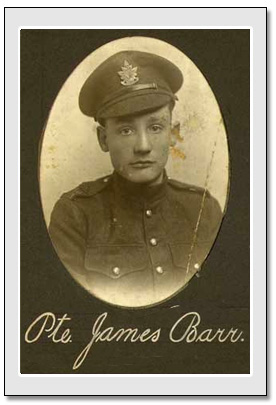
James Barr
James Bland
My father, James Bland, born on Nov. 14, 1894, immigrated from Lancashire, England, and arrived in Canada on July 21, 1912. He enlisted with the Canadian Overseas Expeditionary Force on July 14, 1915. He served in England and France, and was wounded in the back and chest on Oct. 26, 1917. He was discharged on Feb. 24, 1919. I don't know if he resumed his employment at T. Eaton Co. as he was 19 years older than my Mother and they married in 1937. At the time, I believe they both worked at Eaton's. My Dad never spoke of his time in the war, but when the Second World War began he tried to reenlist. I was 3 and my brother was 4. One of my earliest memories was when he came home and told my Mom that he was rejected due to a medical condition. He was very disappointed but I think my Mother was very relieved. Sadly for us, he died from cancer on Feb. 21, 1953, and I still have the letter of sympathy from T. Eaton Co.
- Beverly Selby
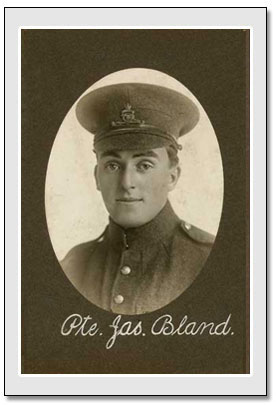
James Bland
Peter Russell Bonner
My grandfather Peter Russell Bonner was from Glasgow, Scotland. He first came to Canada via Toronto, but found work at Eaton's as a jeweler at the Winnipeg location. His enlistment papers of 1916 show his Winnipeg address and belonging to the 100th Battalion (Winnipeg Grenadiers).
He went back to Great Britain during the war as part of the Canadian Expeditionary Force. I'm unsure if he ever saw battle. When he returned he came back to Toronto and Eaton's. In Toronto, he was affiliated with The Queen's Own Rifles of Canada and was a bandsman who played at the Canadian National Exhibition and The Queen's Own Rifles functions. He played many instruments but was known for his alto sax.
He married Marjory D.A Smith in 1927, had one son Allan and continued to work for Eaton's as a jeweler his entire life. I was told he was proud to be a part of the Eaton's extended family. Employees were close and treated well. We still have Christmas cards that Flora McCrea Eaton would send to all employees.
I have a mantel clock, a watch and two end table lamps which were given to him at different stages of his time there. Many buttons, crests, his instruments bring him to life for me. He passed away in 1956 years before I was born. Most importantly I wear the engagement and wedding band he crafted for his bride and worn by my mother as well.
- Stacey Bonner
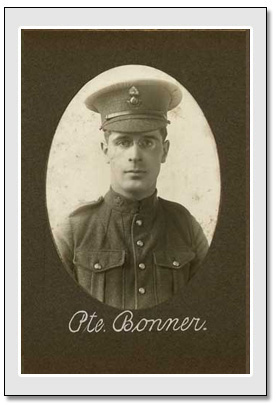
Peter Russell Bonner
Benjamin William Bridgford
My grandfather, Benjamin William Bridgford, was born in Stourport-on-Severn, England, in 1895. His family immigrated to Toronto in 1909 and prior to the beginning of the Great War, he worked as a bookkeeper at Eaton’s.
He enlisted as a sapper (Field Engineer) in the 204th battalion Canadian Expeditionary Force (CEF) in March 1916 and trained at the Stanley Barracks, now the CNE grounds in Toronto. Ben served in France at the battle of Vimy Ridge in 1917 as a Lance Sergeant, 4th Canadian Division, 11th Infantry Brigade, 75th Battalion, Canadian Corps Headquarters, Signal Co. CE. (The 204th merged with 75th Battalion overseas, which later became the Toronto Scottish Regiment.)
Upon his return home he continued working at Eaton's, where he met and married Isabella B. Langlands of Dundee, Scotland, in 1921. In later years, Ben managed the Hardware Department at Eaton's and served as the President of the Eaton Veteran's Association. He was also a member of the Canadian Legion, The Sappers Club of Toronto and the Toronto Scottish Ex-Sergeant’s Club. In 1936, he returned to France as a part of the Canadian Legion Vimy Pilgrimage delegation. The special passports provided by the Government of Canada for the Pilgrimage were the first non-British Canadian passports to be issued.
Ben remained with Eaton's until his retirement and he passed away in 1980. I have the engraved medallion presented to him by Sir John C. Eaton in recognition of his service in the Great War.
- William Lee Bridgeford
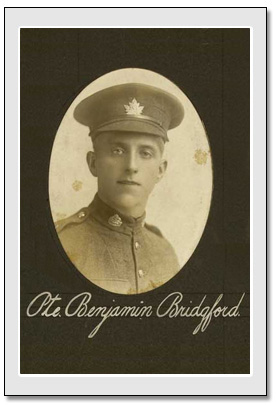
Benjamin William Bridgford
Charles Edwin Cooper
Charles Edwin Cooper was born in England on June 11, 1880. He immigrated with his family to Canada and arrived in Halifax on April 4, 1881. The family settled in Toronto, Ontario. He was one of six children of William Cooper and Minnie Smith. He joined the T. Eaton Company sometime around 1902 or 1903 working in the picture department as a picture framer. On June 10, 1903, he married Sarah Cadwell Sutherland. On September 22, 1914, Charles signed his Attestation Papers and according to his obituary in the Toronto Star, he enlisted as a colour-sergeant instructor and rose through the ranks. At the time of his death on April 28, 1917, while leading his men at Vimy Ridge, his rank was acting Major. In the fall of 1916 he was awarded the Military Cross at Buckingham Palace for a conspicuous gallantry during operations. He led his company with great dash in the attack, cleared an enemy strong point and then rushed on to his objective, which he also cleared and then consolidated. He set a fine example (From the Military Honours and Award Citation Cards written by General Byng). According to his obituary, he was also leading his men and never stayed until he had swept past the objective and consolidated the position at Vimy Ridge when he died. He is buried in Ecoivres Military Cemetery in Pas de Calais. Sadly for the family, his younger brother Herbert Arthur Cooper also died at Vimy Ridge on April 9, 1917.
- Margaret Revell
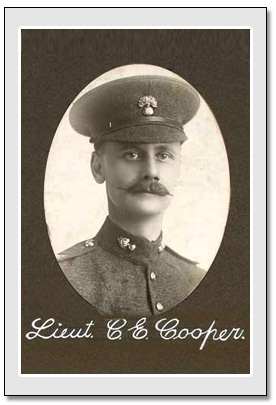
Charles Edwin Cooper
Herbert William Graham
Gunner Herbert William Graham was my grandfather. I remember him as a quiet and kind man. On vacation, our young family of 6 made a long hot drive from Pointe Claire to Toronto in a small Morris Oxford. Arriving at their home, Grandmother ushered the parents inside, and Grandfather whisked us kids off to the neighbourhood wading pool. As kids we were told he worked at Eaton’s as a carpenter, building store displays, and that he fought in the First World War, which damaged his hearing. He had a best friend named Lyons who was blinded in the War, yet became a successful businessman out west. They had a reunion in the 1940’s. Grandfather enlisted in June 1915 aged 33. He served in Ypres, France with the 21st Battalion, 6th Howitzer. He was promoted to Bombardier, suffered shrapnel wounds, was decorated and demobilized in February 1919 in Toronto. Grandfather worked for Eaton’s most of his career. There, he met my grandmother Nellie who worked in the Eaton’s Art Gallery. He was about 50 when they married and she was about 40. Dad was born 10 months later. Grandfather’s cousin Alice Innes, ARCA, was a well-known artist who ran the OCA summer school at Port Hope and painted with the Group of Seven. She was often at their house. My father and brother continued in the military, graduating RMC Kingston. Dad was a mechanical engineer in the 48th Highlanders and my brother a computer engineer in the Navy.
-Susan Graham
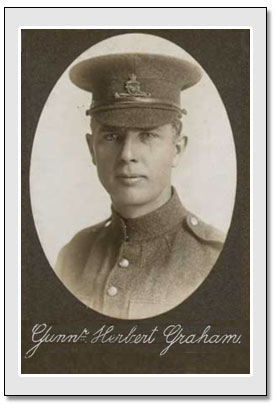
Herbert William Graham
David Gordon
My grandfather, Driver David Gordon I0073097, worked on a ship that traveled back and forth from Britain to Canada. Mr. Eaton traveled on the ship often for business. He liked Grandpa and told him if he ever wanted a job in Canada to come see him. My grandmother's family was immigrating to Canada from Scotland when Grandma was about 17. Grandpa fell in love immediately. When they arrived in Canada, Grandpa decided to stay and asked Mr. Eaton for a job. First, Grandpa worked in the stables. It is my understanding that there was an accident and one of the Eaton children was thrown off a horse and was either very badly injured or died. The Eaton family did not have stables after that. Grandpa became a driver for the Eaton family. Later Grandpa worked at Eaton's College Street in the eye glass department. Grandpa retired from Eaton's at about age 65.
Grandpa was in the First World War and fought at Vimy Ridge.
We gave Grandpa's pay packet to a cousin a few years ago. I have emailed her to see if she still has it as well as any pictures.
My father, also David Duncan Gordon, worked at Eaton’s for 48 years and was in the Second World War.
-Nancy Blakely
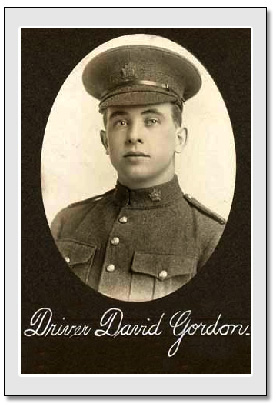
David Gordon
Eric Heathcote
My grandfather, Eric Heathcote, turned 18 in January 1915 and volunteered that spring with the full support of the T. Eaton Company, whose policy was to protect the job of any employee who joined the forces. He had been working with the T. Eaton Company in their art department since 1912. He enlisted in the infantry and was assigned to the Canadian Cyclists Corps.
He survived Vimy but was wounded, gassed, and blinded at Passchendaele. He had a long convalescence in hospital but after a few months regained his sight.
By September 1918, he was attached to the 11th Brigade HQ. A captain, a sergeant, and my grandfather were chosen to make a reconnaissance from a sunken road where the Battalion was dug in. At 11:00 p.m. they went over the top into No Man's Land and pushed on for about 3/4 of a mile until they arrived at a quarry, where they took shelter. At daylight, to their surprise, they spotted hordes of Germans at a distance of about a half-mile.
Their communication line had been severed by shelling, so Eric volunteered to carry a message back to the Brigadier.
In broad daylight, he took off, over broken ground and sunken roads, and immediately came under German fire. By taking advantage of sunken roads and by crawling, he finally arrived where the Brigade was awaiting the command to push forward.
He was awarded the Military Medal, served in the Second World War, and retired in 1962 as Eaton's art director.
Blake Heathcote
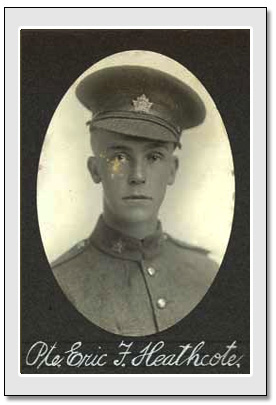
Eric Heathcote
James Hughes
My paternal grandfather, James Hughes, worked in the Printing Department of Eaton’s and had enlisted on July 31st, 1915, a month before he turned 28. He was born in Liverpool, England and came to Canada as a baby. He must have been a fast runner (his height was 5’ 7”) as he was made a Scout in the 75th Battalion which was named the Mississauga Horse and was commanded by Lieutenant Colonel Samuel G. Beckett. This Battalion was formed in three short weeks and was made up entirely of enlistees from Toronto, Hamilton and London, Ontario.
James served overseas in the trenches at the battle of the Somme. He developed trench fever and suffered a sprained ankle for which he was in the hospital in France for a period of time. His discharge date is listed as December 13, 1917.
Upon his return, he and his wife must have had difficulty adjusting back to normal life together as he would disappear from the family for periods of time. (Sadly, one of their sons died at the age of 9 in 1918. Another had been stillborn.) My father was 16 the last time he saw his father James and they never knew what had happened to him. My online search in recent years led me to find out that he actually moved to the United States - specifically Alameda, California. He died in 1962. My father never knew this as he passed away before I discovered this information.
My father, William P. Hughes, also worked at Eaton’s for 47 years and strangely enough in the Printing Department, the same as his father. He was a Compositor and worked at printing the Eaton’s Catalogue before it was discontinued in 1976 at which time he retired a bit early at the age of 62. He served overseas in England during WWII in the RCAF as a mechanic fixing the Lancaster bombers.
- Jane Calder
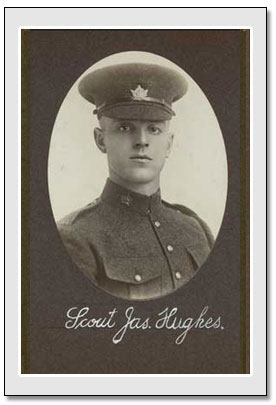
James Hughes
Frederick Thomas Jackson
Corporal Frederick Thomas Jackson (ID #10073161, EMGB #666) was employed by the Eaton Company. His brother, my grandfather, Alfred Robert Jackson (EMGB #920) was invited to join by his brother Fred to make up the numbers for the battery. He was 36 yrs. old when he enlisted, so he became the batman for the commanding officer. T. Eaton Company paid their wages while overseas.
In France, the EMGB suffered many losses and was disbanded. Alfred was discharged at this time, on October1, 1916. He returned home where he worked on war work. He died January 28, 1932 lifespan shortened by the gassing at Ypres.
Five brothers enlisted, but only Fred and Alf worked at Eaton's.
We have copies of attestation papers for both Fred and Alf. As well as photos.
- Jane Pliva
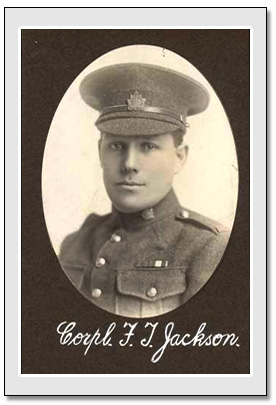
Corporal Frederick Thomas Jackson
Albert E Miller
My grandfather was one of these soldiers, Albert E Miller. He is listed in your records and you have a photo of him, in his younger years as a Private. From my Dad's records, Albert joined the Mississauga Horse, 75th Battalion, 4th Division.
In 1912, Albert emigrated from Belfast, Ireland, to Toronto and gained work with Timothy Eaton. He planned to establish himself before sending for his fiancée, Marion Ellis. However, with the outbreak of war, their marriage was delayed.
We don't know if Albert was one of the first to join up in 1914, but we do know that he survived the war and rose to the rank of Corporal. He certainly fought at Vimy Ridge on that fateful Easter day that cost Canada so much. We have an RMS Mauritania postcard, posted on 6th June 1919, advising Marion that he had finally landed back in Canada at Halifax.
He returned to work in Eaton's becoming an assistant manager. In 1919 he eventually married Marion, initially living at 227 Withrow Avenue and then at 52 The Lindens Bain Avenue (the flat was still there in 2001) and my father was born on Victoria Day, 24th May 1924. Unfortunately, Albert took ill on Easter Sunday, 1929 and had an operation to remove his appendix, but died the next Friday due to internal bleeding. He is buried in Mount Pleasant, Plot No P8578, a flat grave stone.
Marion and their son, Edmund John, returned to Belfast. Our thanks to the Masonic of Toronto, who funded my Dad's education in Belfast. Edmund became a GP in N. Ireland, but never relinquished his Canadian citizenship. He considered returning to Canada in the mid 1950's but decided that due to the tough Canadian winters he would rather work in North Ireland and holiday in Canada, than the other way around. He retained many friends and contacts in Toronto.
We still have a few artefacts of Albert, the same photo that you have of him as a private, a photo as a Corporal, a BEF 75th Battalion Canadians group photo (13 soldiers) taken on 17th March 1917, one of Albert in later life, his medals, together with a small paper knife made from two bullet cartridges with Vimy on one side and Marion on the other.
We also have some Eaton family Xmas cards and the Eaton Order of Service, Unveiling of Memorial to Our Gallant Dead.
- John Miller
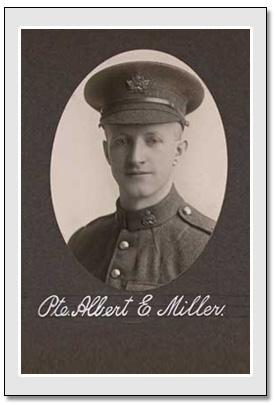
Albert E Miller
Andrew Percy
My grandfather, Corporal Andrew Percy, worked in the Toronto Eaton’s store in the electric department prior to the start of the Great War. My grandmother, Elsie Rhoda Shewring worked there also before their marriage in 1918. My grandfather joined the 3rd Toronto Battalion in September 1914 and was part of the first Canadian Contingent, training first at Valcartier, Quebec, then doing further training on the Salisbury Plains in England in early 1915. The Battalion arrived in France in February 1915. My grandfather was part of the medical corps as a stretcher bearer and water carrier. He was at the 2nd Battle of Ypres and the Battle of Vimy Ridge. In a letter home, dated February 1917, he mentions that Eaton’s was paying the soldiers while they were away and that it was part of Sir John C. Eaton’s part towards the War. After he returned home in June 1917 (due to the death of his stepfather), he spent some time assigned to the Whitby Military Hospital, then returned to Eaton’s. To the best of my mother’s recollection, he remained with Eaton’s until he took sick around 1947 from effects of the war. His last position was as an elevator operator in the Annex. He died in 1961. I have the engraved gold medallion presented to my grandfather by Sir John C. Eaton in recognition of his service in the Great War.
- Cathy Scattergood
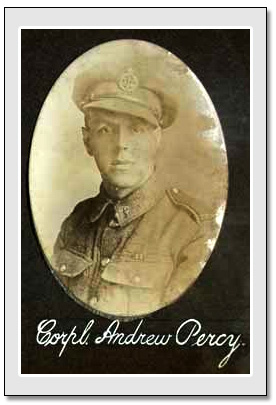
Andrew Percy
Vincent Stephen
One of the Eaton’s employees who served in the Armed Forces during the First World War was Vincent Stephen. He was a much-loved brother of our grandmother and although we never met him we knew of him through her stories of the Isle of Man.
Vincent Stephen was born May 25, 1889 in Liverpool, Lancashire, the youngest son of parents, Thomas Stephen and Ann Jane Lace. His father was a Master Mariner and moved between the Isle of Man and Liverpool according to his work.
Vincent was raised in Ramsey, Isle of Man, and was Captain of the Championship Ramsey Football Club in 1909. He immigrated to Canada and worked at the Eaton’s store in Toronto before joining the Canadian Expeditionary Force (CEF) on May 8, 1916. He was shipped out to England on November 30, 1916 on board RMS Mauretania and arrived in France on December 5, 1916. He moved to the front lines on March 24, 1917 as part of the 75th Battalion of the CEF.
He was killed in action on April 2, 1917 at Vimy Ridge during a night patrol of the German lines, in preparation for the Canadian Army’s historic advance up Vimy Ridge.
Vincent was engaged to a young Ramsey lady and the week previous to his death he met the young lady’s brother who was serving in an English battalion. Their officers allowed them to have a chat for a while. Both Vincent and his fiancée’s brother were killed within a week of the meeting.
We thank your organization for remembering these young men who volunteered to defend the country in one of the major events of the twentieth century.
- James B. Smith
Coquitlam, BC.
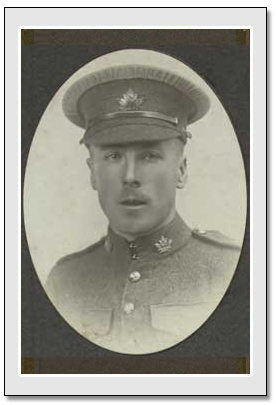
Vincent Stephen
Roy Sproule
Roy Sproule was born in Toronto on March 9, 1900, where, except for his years of military service, he lived most of his life. He was the son of George and Thelma Tillya Sproule and the brother of Annie Revell (Sproule). He joined the T. Eaton Company sometime shortly before WWI, possibly as a sales clerk. Annie’s stepson was told by Roy that he lied about his age to get into the army because he thought it was his duty to serve. His Attestation Paper, signed on August 23, 1916, shows a birthdate of March 19, 1898 - not March 9, 1900 as shown on his birth records. His mother was not pleased. Roy saw considerable action at the front including at Vimy which he described as a hill not unlike the Niagara Escarpment. It is believed by the stepson that Roy returned to work at Eaton’s after the war but Roy wanted to be a police officer, a dream realized when he turned 21 in 1921. He took leave from the Toronto Police to serve as a sergeant in the Canadian Military Police in WWII. Although never wounded, Roy developed what was known as trench feet from living in flooded trenches in wet boots. He was plagued with painful feet the rest of his life. He was proud that he had done his duty by serving in both wars. Roy died in Coldwater, Ontario in 1977.
- Donald Revell
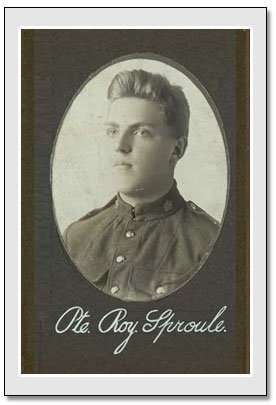
Roy Sproule
Dalton Strype
Dalton Strype was employed by the T. Eaton Company before, during and after WW1 where he enlisted in the British expeditionary force in 1915. Dalton was deployed to the European theatre of operations and saw action at Passchendaele and Vimy Ridge. I remember the story of how he was wounded and spent his convalescent in a large British home. Dalton led a battalion of solders across a mine field near Belgium. For this act of bravery he was awarded the Military Cross and Bar by King George V of England. Dalton ended his service as a Captain and upon his return to Canada, his medical bill had to be paid. When our grandmother, Margret (Daisy) Strype, went to settle up the large medical bill, the invoice stated paid in full by the T. Eaton Company.
Dalton worked in the audit office of Eaton’s and later took care of travel arrangements for J.C Eaton by having the Eaton rail carriage pulled across the country by the CPR.
Dalton was struck down by a massive stroke and lost both legs and the use of his left arm. As a retired fire officer in York Region I march alongside other service members in a Remembrance Day ceremony and I carry my Papa’s service swagger stick to commemorate Dalton Strype’s memory.
- Glen Strype
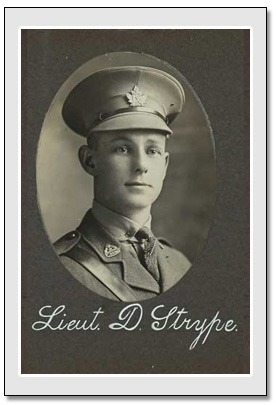
Dalton Strype
Waring Tooze
I was born in 1943 and raised in the Beach neighbourhood of Toronto. As a young boy, I loved nothing more than going downtown with my mother at Christmas time and marveling at the decorated windows at both Eaton's and Simpsons. The highlight for me was the Eaton's Santa Claus parade and the subsequent visit to Toy Land and Santa himself, which I recall was on the fifth floor of Eaton's main store.
For many years, I was always surprised that when I sat on Santa's lap, being prepared to tell him what I would like to receive for Christmas he knew my name and knew many of the things that had taken place in my life over the past year. He would also tell me he had received my letter and already knew what I had wished for.
I didn't find out until years later, that the man behind the white beard was a good friend of my parents. Although I don't recognize him from the picture posted on the website, I know he visited our home on many occasions during the 1940s and 1950s.
My parents always referred to him as Wary Tooze, but to me and probably thousands of others in their 70's and 80's, he will always be Santa Claus.
I have attached a website that quotes Waring Tooze as he describes the Santa Claus Parade prior to the First World War. More Details Here.
- Albert Barr
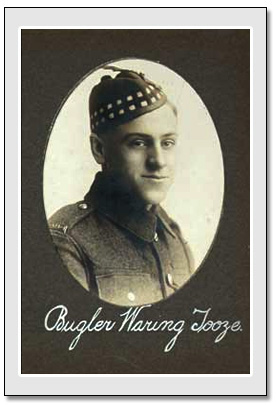
Waring Tooze